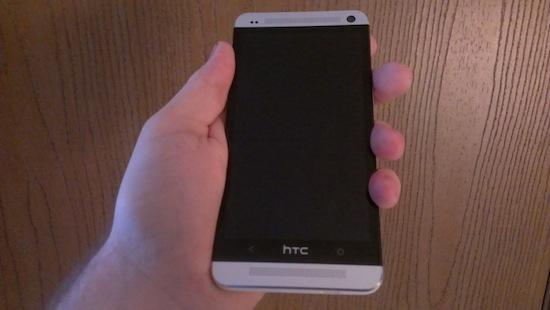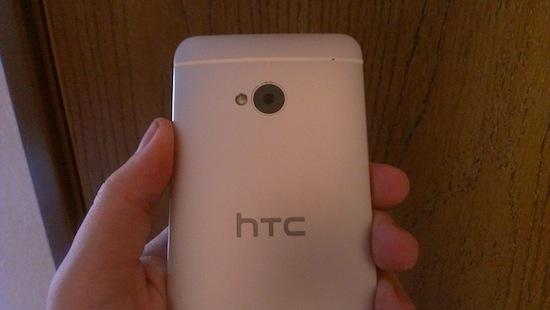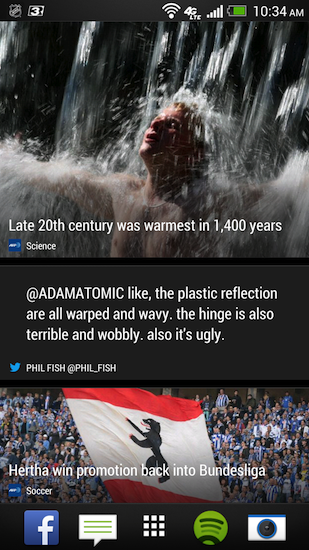The HTC One. A device that many believe is the last stand for a company that has certainly seen better days. A device that drops any kind of additional identifiers, like 'X' or 'S' and aims straight to the point. HTC wants you to believe that this is a phone that is everything your current device isn't. HTC wants you to believe that this phone, without any confusion, really is "the one." But is it the one for you? Is the One the next device that you should spend your hard earned money on? Do all the notable features really stand out in the sea of Android devices?
Let's find out.
Design and Features
If you have been watching coverage of the HTC One here on PhoneDog, then you know that Aaron Baker loves the One's hardware. In every single video of the device, even the ones focusing on software, he's found a few moments to mention how good the hardware is. I took note of this, obviously, so I have been looking forward to getting my hands on the One's hardware since its unveiling.
And let me be perfectly clear: The One is a remarkably beautiful device. Just looking at pictures on the Internet, or hearing people talk about it, isn't enough. You have to hold it in your hand, turn on the display, and experience it firsthand.
On the front of the device, there's plenty to grab your attention. At the top, you'll find one of the two speaker grilles, along with the front-facing camera and a pair of sensors. Right below that, the 4.7-inch 1080p HD display, which boasts a pixel per inch count of 468. Right below the display rests the HTC logo, with the back button on the left, and the Home button on the right. Finally, at the very bottom, the other speaker.
The capacitive button placement, along with the fact that HTC decided to go with just back and Home, was an interesting design choice. If you're moving to the One from another Android device, it's perfectly understandable that you'd find the button choice a bit more aggravating. However, I didn't find the buttons to be that bad, especially after a few hours of usage. I got accustomed to them quickly, and I'm happy to admit that I never pressed the HTC logo in hopes that something would happen.
On the back of the One, you'll find the 4 UltaPixel camera, along with the LED flash next to it. There's another HTC logo engraved into the curve of the phone. AT&T is sticking with their new branding ideas, and went with the small globe near the bottom of the device. It sits nicely above the Beats Audio branding.
Looking over the handset, you'll find the power button at the top-left, which doubles as an IR blaster, and a 3.5mm headphone jack near the top-right. On the right side of the handset is the volume rocker; at the bottom, the micro USB port; on the left, you'll find the micro SIM card slot. It's all held together by a metal frame with a curved back that feels amazing in the hand.
My *only* complaint about the hardware is the power button. It's positioning isn't the best, even for a right-handed user. Worse, though, is that it's recessed into the frame just a bit too much. It was a pain to find at first, but eventually muscle memory kicked in, so it isn't as big of a complaint as it was at first.
HTC's decision to go with metal and glass, to give the device a slightly curved back, and make sure that there's a bit of weight to the phone all come together to make this easily one of the best Android smartphones on the market, if not ever. Android has been waiting for a piece of hardware like this.
Usability and Performance
The HTC One is running Android 4.1.2 Jelly Bean, and Sense version 5.0. We've covered Android 4.1 in-depth in other devices, so I'm not going to touch on many aspects of the mobile OS itself. Instead, a lot of the focus needs to be put on Sense itself, and the changes that HTC brought to the table for their newest flagship device.
The first thing you'll notice is what HTC is calling BlinkFeed. It's meant to work as a news and social media aggregator, and it does this fairly well. There are plenty of different news sources you can choose from, including the Associated Press, Reuters, and others. It will also collect your social media updates, from options like Twitter and Facebook. It puts it all together in a vertical tiled list, which you can flip through, like we've seen in apps like Flipboard in the past.
The layout itself is strange. It changes with each swipe up or down, showing you a different number of stories and updates every time. Sometimes you'll get two on big tiles, and other times you'll see as many as four, thanks to smaller tiles that sit vertically, rather than horizontally. It's a way to change things up, I think, so you don't get bored looking at what you're looking at. Thankfully, interacting with BlinkFeed is smooth and quick, with no lag. Stories open quickly, too, and you can share them in a multitude of ways right from the story itself. You can also post to your linked social networks right from BlinkFeed, which is a nice touch.
HTC also put a lot more focus on the app drawer this time around, allowing you to make folders therein, as well as change the way app icons are displayed in different orders. Another nice touch is that the weather information stays at the top of your app drawer, so you can see it while sorting through your apps. It's an interesting move, and I think it goes to show that HTC believes you spend a lot of time in your app drawer. It also shows that maybe they believe you'll want to stay on BlinkFeed, and go right into the app drawer, without ever seeing one of the traditional home screens.
Unfortunately, HTC has also made some really unorthodox and maddening changes to Sense, the app drawer, and the way that we move application icons.
If you open the app drawer, for instance, and press and hold an app icon, in hopes to move it to a home screen? It doesn't work as other Android devices have in the past, including HTC devices. Instead of the app drawer fading out, and allowing you to set the app icon where you'd like, all you'll see are options at the top appear. These are 'uninstall' (depending on the app), and 'shortcut.' You'll also notice that the bottom row of icons don't move, or wiggle. Nothing changes, save for those two options at the top.
You have to drag your app icon to that 'shortcut' option, if you want to put an icon on your home screen. It's not impossible to figure out, but it's an extra step that seems completely pointless. Also, you can't hit the back button to get out of the app drawer. It just doesn't work. You *have* to hit the Home button to get out without setting an application shortcut.
If you do use your home screen, don't try to move an app icon out of the bottom row of apps to the home page. It will work, yes, but as Aaron has shown us in the past, it actually *creates a duplicate* icon. I have *no idea* why this happens. If you want to move an icon out of the bottom row, you need to open the app drawer and drop it into there. You can also only move apps into that bottom row from within the app drawer. These are annoying issues, and I'm still finding myself trying to do things "the old way," rather than the way that HTC wants me to do them more often than not. However, I enjoy the new look of Sense, and I can't say that the experience has slowed down with more usage, as has been a major gripe of mine in previous versions of Sense UI. Behind the scenes, the alterations that HTC made to Sense seem to be great all around.
The 1.7GHz Qualcomm Snapdragon 600 quad-core processor keeps everything ticking along nicely, and applications open smoothly, without any noticeable lag in switching back and forth from one thing to another. The 2GB of RAM also helps, and just goes to show that HTC took the internals of the phone just as important as the external design and features.
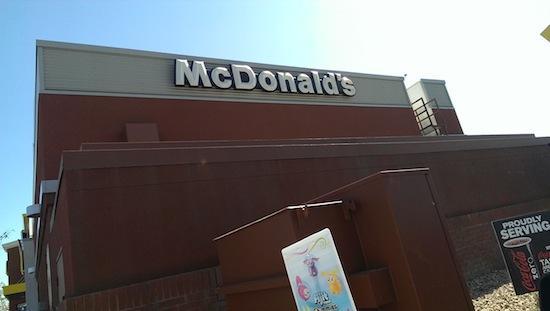
HTC made a lot of noise about their 4-UltraPixel camera, and from my own usage, I can say that it's a powerful camera, and it does indeed get the job done. If you're someone who takes photos to primarily share on social networks, the UltraPixel camera will definitely make you a happy camper, especially in many low-light situations. A nice additional feature to the camera is HTC Zoe, which allows you to take three-second snippets of high-res images. You can then put them together into a sort of Vine-like video, and share them as you see fit. It isn't groundbreaking or anything, but it's a nice built-in feature, especially those who love to share new photos on their social networks.
Call quality on the One is better than I've noticed on previous devices. It was crystal clear on my end, and when I asked those I spoke to if they could hear a lot of ambient noise, they all told me no, even as I was walking along a busy road. My AT&T 4G LTE speed tests resulted in some of the best download speeds I've seen on a handset since 4G LTE launched here, while uploads were about right where they've always been. My battery life hasn't broken any records, and the One can't compete with devices like the Galaxy Note II, but it wasn't terrible, either. After just over 15 hours, the battery was still at 21 percent. I have no doubts that the One should be able to get most people through the majority of their day, and well into the evening, as long as you don't mind dipping passed thirty percent of life remaining.
In the end, and I can't say this enough, the HTC One is absolutely the device Android has been waiting for, as far as hardware is concerned. HTC has made a phone that's arguably better in the hand than Apple's iPhone 5. The 4.7-inch display is a good size, and the 1080p HD is something you feel okay just staring at. HTC BoomSound is probably one of the best additions to a smartphone in a very long time, and it makes you wonder why it took so long for *any* phone manufacturer to put speakers on the front of the device. Little things, like the notification light in the top speaker grille, is just icing on the cake, as far as I'm concerned.
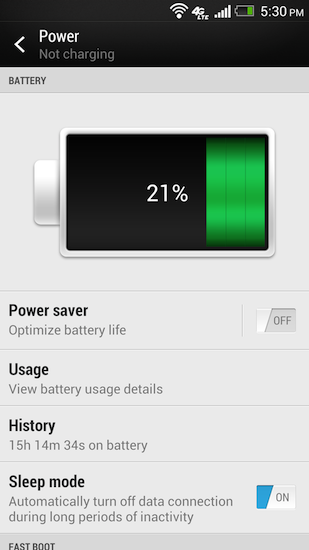
The One is missing features that Google implemented in Android 4.2, but it doesn't ruin the experience on the One by any means. The changes that HTC implemented, especially in the app drawer and the way app icons are moved, is more annoying than anything else, but I see it as a learning curve for picking up a new phone. HTC wants to make their phones different, and I guess this is one way to do it. Even if it does add unnecessary steps.
Conclusion
Is this the device to get? Is this the one for you? If you're already a fan of Android, then absolutely. You'll want to show this phone off to everyone, and I have no doubts that you'll want to have it in your hand more often than not. Should you switch from a different platform to the One? That depends on plenty of variables, like how entrenched in your current mobile OS you are. Are you too invested to switch to a new platform? If so, it probably doesn't matter how great the One is.
Because the One is great. It's easily one of the best phones I've ever had the opportunity to review, and one of the best phones I've ever used. No smartphone or device is perfect, so don't expect the One to be. However, it's positive qualities far surpass its negative aspects.
The Verdict
What's Good: The HTC One's physical design is second-to-none. The display is amazing. The UltraPixel camera takes great photos for sharing on social networks. Battery life is good. HTC BoomSound and Zoe are fantastic additions to the feature list.
What's Bad: Changes to the way users interact with app icons aren't intuitive. BlinkFeed can't be deactivated completely. UltraPixel camera doesn't meet HTC's hype.
The Verdict: The One is *the* flagship device for Android in 2013, even compared to devices like Samsung's Galaxy S 4, due to the top-tier quality of its hardware. the changes that HTC has made to Sense UI overall, excluding some of its minor quirks, are a welcomed sight for sore eyes, and was worth the wait. If you want an Android device, the One is a safe bet.
